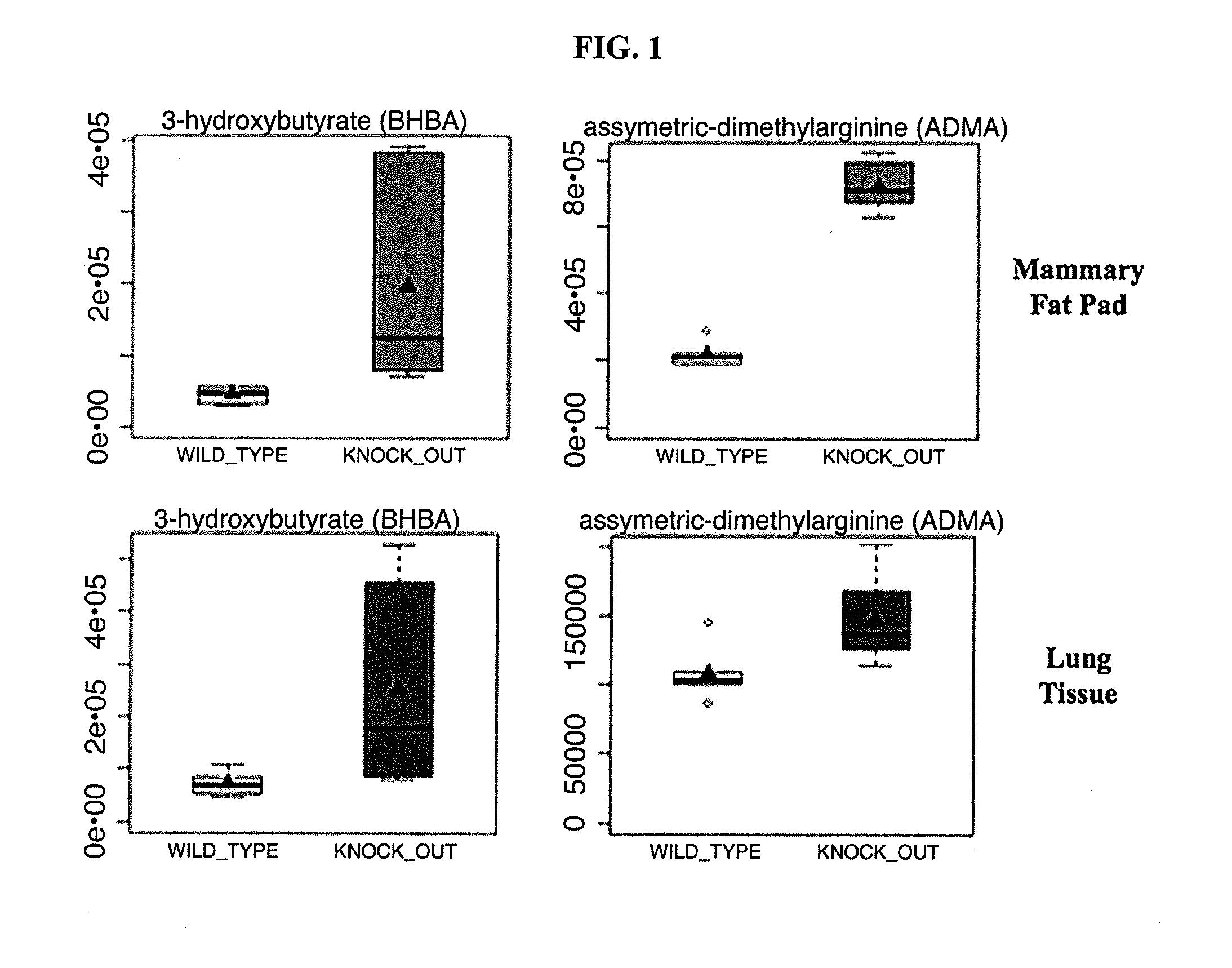Prognosis and treatment of breast cancer
a breast cancer and prognosis technology, applied in the field of prognosis and treatment of breast cancer, can solve problems such as poor clinical outcomes
- Summary
- Abstract
- Description
- Claims
- Application Information
AI Technical Summary
Benefits of technology
Problems solved by technology
Method used
Image
Examples
example 1
Metabolomic Analysis of Cav-1 (− / −) Null Tissues from Mammary Fat Pads
[0072]Mammary fat pads were harvested from age-matched female WT and Cav-1 (− / −) null mice (n=6 for each genotype) and subjected to an unbiased metabolomic analysis. Over 200 known compounds were identified by mass spectrometry analysis and their levels were quantitated. Interestingly, a large number of compounds were significantly changed in Cav-i (− / −) mammary fat pads (n=103; 92 UP; 11 DOWN), consistent with a severe metabolic phenotype. See Table 1.
[0073]In Table 1, fold-changes (knock out / wild type) are shown in parentheses after each metabolite that showed a significant change (p≦0.05). In one case, an asterisk (*) indicates p≦0.1. Metabolites showing an increase of 2.5 or greater are underlined. All other p values were p≦0.05.
[0074]Table 1. Metabolomic Analysis of Mammary Fat Pads from Cav-1 (− / −) Deficient Mice
(A) Amino Acids:
[0075](1) Alanine and aspartate metabolism: alanine (1.7); asparagine (2.3); aspa...
example 2
Metabolomic Analysis of Cav-1 (− / −) Null Tissues from Lung Tissue
[0117]We also independently compared our results from the mammary fat pad with lung tissue, as adipose tissue and lung tissue express the highest levels of Cav-1. Only concordant changes were selected and are shown in Table 2. ADMA, pyruvate and BHB were significantly elevated in lung tissue, consistent with the idea that Cav-1 (− / −) null tissues are undergoing (1) oxidative stress and (2) mitochondrial dysfunction. Box plots for ADMA and BHB are shown in FIG. 1.
[0118]In Table 2, only shown are metabolites and fold-changes of knock out to wild-type (KO / WT) showing concordant changes in both the mammary fat pad and lung tissue. An asterisk (*) indicates p≦0.1. All other p values were p≦0.05.
TABLE 2Metabolomic analysis of mammary fat pads and lugtissue from Cav-1 (− / −) deficient miceMammaryLungMetabolites(KO / WT)(KO / WT)pipecolate1.91.3assymetric dimethylarginine (ADMA)3.31.4glycylproline2.81.4pyruvate1.4*1.9carnitine0.90....
example 3
Micro-RNA (miR) Profiling of Cav-1 (− / −) Stromal Cells
[0119]Cav-1 (− / −) stromal cells were subjected to miR-profiling as described in Materials and Methods. The results, shown in Table 3. demonstrate that only a select number of miRs were transcriptionally upregulated in Cav-1 (− / −) stromal cells. For this analysis, we chose a cut-off of 1.5-fold increased (KO / WT). P-values are as shown. In Table 3, “ns” means not significant. miR-31 and miR-34c showed the most significant p-values. Notably, miR-31 and miR-34c were increased 4.2-fold and nearly three-fold, respectively.
TABLE 3Upregulation of miR's in Cav-1 (− / −) null stromal cellsSymbolFold change (KO / WT)p-valuemiR-314.240.002miR-34c2.950.01miR-423-3p2.180.02miR-193b2.080.09 / nsmiR-423-5p1.990.03miR-342-5p1.960.05miR-2101.740.07 / nsmiR-574-3p1.720.02miR-1821.710.04miR-2981.710.04miR-281.70 0.1 / nsmiR-7441.68 0.1 / nsmiR-20b1.62 0.1 / nsmiR-467h1.590.07 / nsmiR-1851.580.04miR-2221.550.04miR-125a-5p1.530.06 / ns
PUM
| Property | Measurement | Unit |
|---|---|---|
| resistance | aaaaa | aaaaa |
| time point | aaaaa | aaaaa |
| concentration | aaaaa | aaaaa |
Abstract
Description
Claims
Application Information
 Login to View More
Login to View More - R&D
- Intellectual Property
- Life Sciences
- Materials
- Tech Scout
- Unparalleled Data Quality
- Higher Quality Content
- 60% Fewer Hallucinations
Browse by: Latest US Patents, China's latest patents, Technical Efficacy Thesaurus, Application Domain, Technology Topic, Popular Technical Reports.
© 2025 PatSnap. All rights reserved.Legal|Privacy policy|Modern Slavery Act Transparency Statement|Sitemap|About US| Contact US: help@patsnap.com

